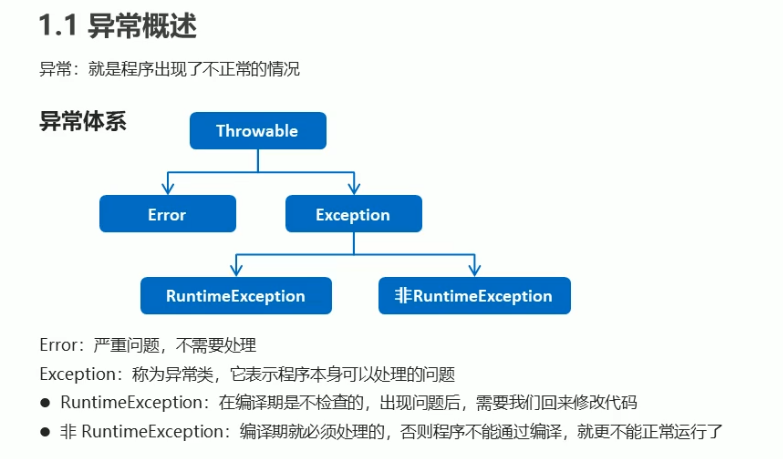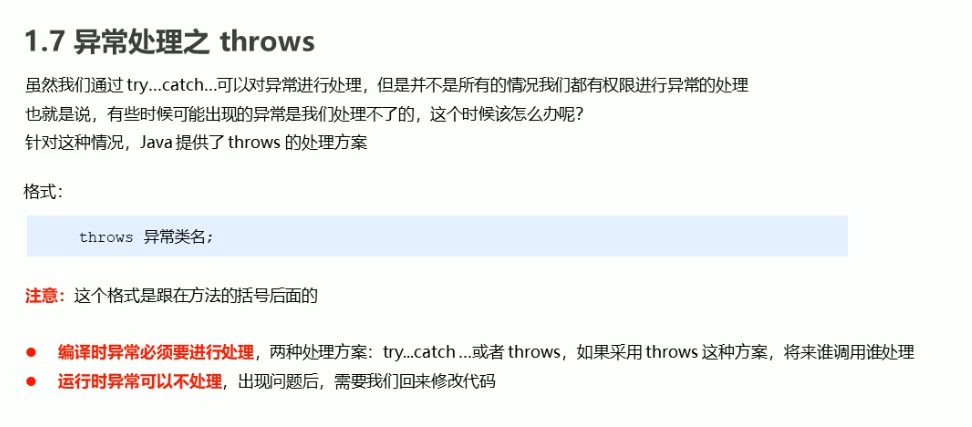1. 异常
1.1 异常(记忆)
- 异常的概述
异常就是程序出现了不正常的情况 - 异常的体系结构

1.2 JVM默认处理异常的方式(理解)
- 如果程序出现了问题,我们没有做任何处理,最终JVM 会做默认的处理,处理方式有如下两个步骤:
- 把异常的名称,错误原因及异常出现的位置等信息输出在了控制台
- 程序停止执行
1.3 try-catch方式处理异常(应用)
- 定义格式
try {
可能出现异常的代码;
} catch(异常类名 变量名) {
异常的处理代码;
}
- 执行流程
程序从 try 里面的代码开始执行
出现异常,就会跳转到对应的 catch 里面去执行
执行完毕之后,程序还可以继续往下执行
/*
try {
可能出现异常的代码;
} catch(异常类名 变量名) {
异常的处理代码;
}
*/
public class ExceptionDemo01 {
public static void main(String[] args) {
System.out.println("开始");
method();
System.out.println("结束");
}
public static void method() {
int[] arr = {
1, 2, 3};
System.out.println(arr[3]);
}
}
输出:
开始
结束
java.lang.ArrayIndexOutOfBoundsException: 3
at Heima.YiChang.Test01.Demo01.method(Demo01.java:13)
at Heima.YiChang.Test01.Demo01.main(Demo01.java:6)
Process finished with exit code 0
1.4 Throwable成员方法(应用)
| 方法名 | 说明 |
|---|---|
| public String getMessage() | 返回此 throwable 的详细消息字符串 |
| public String toString() | 返回此可抛出的简短描述 |
| public void printStackTrace() | 把异常的错误信息输出在控制台 |
/*
public String getMessage():返回此 throwable 的详细消息字符串
public String toString():返回此可抛出的简短描述
public void printStackTrace():把异常的错误信息输出在控制台
*/
public class ExceptionDemo02 {
public static void main(String[] args) {
System.out.println("开始");
method();
System.out.println("结束");
}
public static void method() {
try {
int[] arr = {
1, 2, 3};
System.out.println(arr[3]); //new ArrayIndexOutOfBoundsException();
System.out.println("这里能够访问到吗");
} catch (ArrayIndexOutOfBoundsException e) {
//new ArrayIndexOutOfBoundsException();
// e.printStackTrace();
//public String getMessage():返回此 throwable 的详细消息字符串
// System.out.println(e.getMessage());
//Index 3 out of bounds for length 3
//public String toString():返回此可抛出的简短描述
// System.out.println(e.toString());
//java.lang.ArrayIndexOutOfBoundsException: Index 3 out of bounds for length 3
//public void printStackTrace():把异常的错误信息输出在控制台
e.printStackTrace();
// java.lang.ArrayIndexOutOfBoundsException: Index 3 out of bounds for length 3
// at com.itheima_02.ExceptionDemo02.method(ExceptionDemo02.java:18)
// at com.itheima_02.ExceptionDemo02.main(ExceptionDemo02.java:11)
}
}
}
/*
public class Throwable {
private String detailMessage;
public Throwable(String message) {
detailMessage = message;
}
public String getMessage() {
return detailMessage;
}
}
*/
1.5 编译时异常和运行时异常的区别
-
编译时异常
- 都是Exception类及其子类
- 必须显示处理,否则程序就会发生错误,无法通过编译
-
运行时异常
- 都是RuntimeException类及其子类
- 无需显示处理,也可以和编译时异常一样处理
import java.text.ParseException;
import java.text.SimpleDateFormat;
import java.util.Date;
/*
Java 中的异常被分为两大类:编译时异常和运行时异常,也被称为受检异常和非受检异常
所有的 RuntimeException 类及其子类的实例被称为运行时异常,其他的异常都是编译时异常
编译时异常:必须显示处理,否则程序就会发生错误,无法通过编译
运行时异常:无需显示处理,也可以和编译时异常一样处理
*/
public class ExceptionDemo03 {
public static void main(String[] args) {
// method();
method2();
}
//编译时异常
public static void method2() {
try {
String s = "2048-08-09";
SimpleDateFormat sdf = new SimpleDateFormat("yyyy-MM-dd");
Date d = sdf.parse(s);
System.out.println(d);
} catch (ParseException e) {
e.printStackTrace();
}
}
//运行时异常
public static void method() {
try {
int[] arr = {
1, 2, 3};
System.out.println(arr[3]);
} catch (ArrayIndexOutOfBoundsException e) {
e.printStackTrace();
}
}
}
1.6 throws方式处理异常(应用)
- 定义格式
public void 方法() throws 异常类名 {
}

import java.text.ParseException;
import java.text.SimpleDateFormat;
import java.util.Date;
/*
throws 异常类名;
这个格式是跟在方法的括号后面的
*/
public class ExceptionDemo {
public static void main(String[] args) {
System.out.println("开始");
// method();
try {
method2();
}catch (ParseException e) {
e.printStackTrace();
}
System.out.println("结束");
}
//编译时异常
public static void method2() throws ParseException {
String s = "2048-08-09";
SimpleDateFormat sdf = new SimpleDateFormat("yyyy-MM-dd");
Date d = sdf.parse(s);
System.out.println(d);
}
//运行时异常
public static void method() throws ArrayIndexOutOfBoundsException {
int[] arr = {
1, 2, 3};
System.out.println(arr[3]);
}
}
1.7 自定义异常(应用)

自定义异常类
import java.util.Scanner;
public class ScoreException extends Exception {
public ScoreException() {
}
public ScoreException(String message){
super(message);
}
}
public class Teachers {
public void checkScore(int score) throws ScoreException {
if(score<0 || score>100) {
// throw new ScoreException();
throw new ScoreException("你给的分数有误,分数应该在0-100之间");
} else {
System.out.println("成绩正常");
}
}
}
import java.util.Scanner;
public class TeacherTest {
public static void main(String[] args) {
Scanner sc = new Scanner(System.in);
System.out.println("请输入分数:");
int score = sc.nextInt();
Teachers t = new Teachers();
try {
t.checkScore(score);
} catch (ScoreException e) {
e.printStackTrace();
}
}
}
1.8 throws和throw的区别(记忆)

println(“请输入分数:”);
int score = sc.nextInt();
Teachers t = new Teachers();
try {
t.checkScore(score);
} catch (ScoreException e) {
e.printStackTrace();
}
}
}
## 1.8 throws和throw的区别(记忆)
[外链图片转存中...(img-QzY5kPLE-1632994192534)]